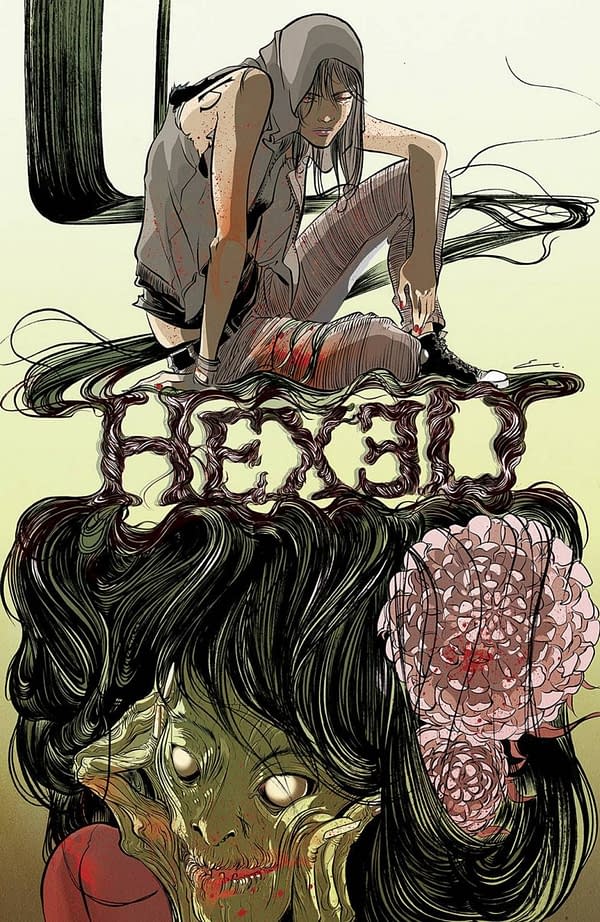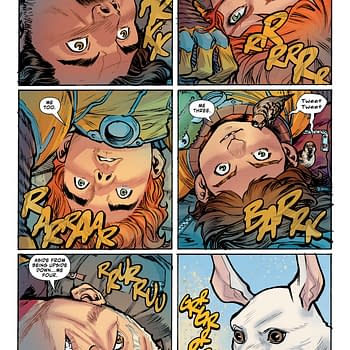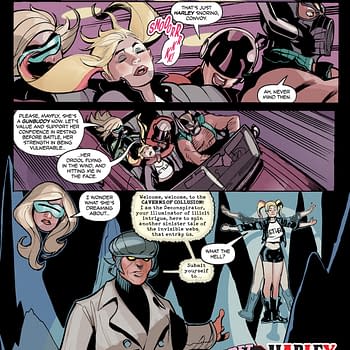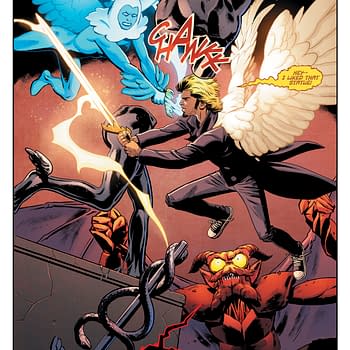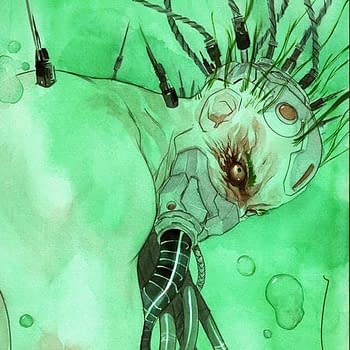Posted in: Comics, Recent Updates | Tagged: astro city, boom studios, Comics, cullen bunn, dc comics, entertainment, Godzilla: Cataclysm, green arrow, hexed, image, jeff lemire, jh williams iii, kurt busiek, vertigo
Thor's Comic Review Column – Green Arrow, Godzilla: Cataclysm, Astro City, Hexed
This week's comics include:
Green Arrow #34
Godzilla: Cataclysm #1
Astro City #14
Hexed #1
Green Arrow #34 (DC Comics, $2.99)
By Graig Kent
"The New 52" botched up a lot of things in its reboot of the DC Universe, but the biggest botch job had to be on Green Arrow. By its third issue the original writer J.T. Krul was off the book, with series artist Dan Jurgens filling in, alongside master sub Keith Giffen. They finished out the first flailing story arc and abandoned ship, for an even more disastrous run from a disinterested Ann Nocenti taking its place. The big guns like Green Lantern and Batman made it through the reboot relatively unscathed, while Superman and Wonder Woman had powerhouse talent like Grant Morrison and Brian Azzarello to guide them. The B-listers were left to sink or swim, and Green Arrow was sucking in more water than air. It looked dire and cancellation was surely afoot… except an unlikely hit television show that had thrust the character into the limelight meant it just couldn't go away.
Enter Jeff Lemire and Andrea Sorrentino, not A-listers, not quite yet, but notable talents and two of very few success stories to come out of the initial "New 52" launch. Lemire had critical success with Animal Man, and modest successes with Frankenstein and Justice League Dark (and seemingly becoming one of DC's key architects in the process). Sorrentino, meanwhile, was one of the biggest finds, making quite the splash entry with the underrated I, Vampire. Putting these two together may not have been the equivalent of putting gold bricks in the vault, but it was at least a sign that DC was committed to turning the property around. And turn it around they did.
With 20 issues (this month concludes their ongoing story, while next month sees their peek 5 years into Green Arrow's Future in "Future's End" as their final issue) Lemire and Sorrentino smoothed out the titles rough beginnings, introduced a whole gamut of rogues and allies to the Archer's gallery, created a deep legacy to the character, and aligned the book with the TV show in slight ways, capitalizing on character's most successful incarnation to date. While I do still miss the tunic, the feathered cap, and the Van Dyke (which Sorrentino cleverly put on Ollie's father's face in "The Outsiders War" arc), Green Arrow now feels like he should: vibrant and fresh, but with depth to who he is and a sense of purpose behind him. The purpose of "The New 52" has been fulfilled for the character, making him a new man independent of the 70 years of history behind him.
It may not have rocketed to the top of the sales charts, but Green Arrow under this team has been rock solid and consistently enjoyable the whole ride. While there's little in Lemire's stories themselves that shake the foundation of comics (it surely rocked the character, but one's milage may vary), what it has as an enviable draw is Sorrentino's art, which never fails to amaze. Constantly presenting widescreen action, Sorrentino broke the mold with his first issue and never looked back. With his heavy use of shadows and razor-thin lines, one could draw an initial comparison to Jae Lee, but the craftiness of his panel breakdowns at times reach the raw inventiveness of J.H. Williams III, and then his sense of movement along the page rival any in the business today.
There's a two-page spread in issue 34 that exemplifies Sorrentino's mastery at storytelling. It finds Arrow and Diggle facing down master of kung-fu, Richard Dragon, pointing an arrow and gun in his direction. There are 10 key panels on this page, the first shaped like an elongated arrowhead to which the others nimbly contort around, but there are also another 12 sub-panels within the main panels that highlight Dragon's tactical brain, rapidly assessing his opponents, and 3 more white-bordered sub-panels highlighting the key focal points of the action, a Sorrentino invention for the series. Whatever influences Sorrentino came into "the New 52" with he wore on his sleeve, but he's since absorbed those inspirations fully and is making cranking out stunning all his own (and on a monthly basis)..
For the first two issues Sorrentino handled the coloring himself, and set in place the standard for what he wanted the series to look like. His deft use of flat colors, color saturation and white space instantly created a look for the series that was unlike any other on the rack. Handing over the reigns to Marcelo Maiolo for the remainder of the series found the colorist following suit, but gradually adding his own sense of color depth to the proceedings, rightfully earning his name on the cover credits this issue.
Without a doubt Sorrentino is going to be a superstar (quite frankly he already should be, but this just didn't quite launch him that high). Over the past year and a half he's grown immensely confident in himself, just as it seems his editor and writer has. Don't be surprised to see Sorrentino handling something epic fairly soon. Writing DC Comics is Lemire's fun job, which he will continue on with the Future's End weekly and Justice League United, but he gets his bona fides from his creator-owned work, of which more is in the pipes. Green Arrow, meanwhile, is left in excellent shape, with a sense of purpose and a hearty roster of colleagues, family and bad guys to share the page with. Whether incoming writers Ben Sokolowski and Andrew Kreisberg (both from the TV show) carry it on or break the new mold remain to be seen, but the foundation is in place to enable a long run.
Graig Kent keeps promising to finish the final edit on that novel, play test that board game, start drawing that web comic, find an artist for that children's book, and maybe write that teleplay, but first he's got to read that pile of comics and watch that backlog of movies…and all that cheese wont eat itself. He's been reviewing things for over 15 years. He's rarely on twitter @thee_geekent, he sometimes writes about movies at [wedisagree.blogspot.com], and his dog has a blog [tacomblur.tumblr.com]
Godzilla: Cataclysm #1 ($3.99, IDW)
By D.S. Randlett (@dsrandlett)
I'm always nervous about comic books licensed from other media properties. Whereas with something like video games there's the rule that a game based on a movie or comic property is going to suck, or that the film is likely not going to be as good as the original book or comic, with comics it's a much more 50/50 proposition. This likely has to do with costs: movies and games cost millions of dollars to make, so the impetus is to deliver something that's going to deliver to the widest array of people as possible. Comics don't cost anywhere near as much as games or films to produce, and play to a smaller niche, and so we're often lucky enough to get different spins or extrapolations on genre material from other media. It's an old trend. Most of comics' oldest concepts were lifted straight from literature, but licensed comics as we know them were likely pioneered by Marvel's Star Wars line, and later their absolutely bonkers Godzilla line, to say nothing of the great work that's been done under Dark Horse's Aliens and Predator licenses.
Despite the lack of basketball and cowboys, I've heard good things about IDW's Godzilla output for a while now, and looking over the summaries of past Godzilla series like James Stokoe's Half Century War revealed some enticing new spins on the Godzilla/Kaiju concept. Being a fan of Cullen Bunn's phenomenal weird west epic The Sixth Gun, the release of a new series with a no brainer kaiju concept written by the man seemed like a good opportunity to finally get on board.
I love the original Godzilla film, which I did not see until last year. It is totally a hokey monster movie at its core (just another reason to love it), but beyond that it's a propulsive and imaginative take on feelings like guilt over World War II and what mankind after the Industrial Revolution is doing to nature, while at the same time reckoning with the sense of vulnerability that came with Japan being the first and only nation to suffer an atomic attack. The Kaiju genre obviously evolved, but whenever it seems like the Godzilla franchise loses its way it manages to find its way back to that soup of themes.
There's some of that in Bunn's script, made most explicit in its first half. What I absolutely love about this issue is that it posits a world in which the monsters have basically won. This puts Cataclysm pretty firmly in the post apocalyptic sci fi subgenre. What's interesting is the book's narration, told from the point of view of an old man who remembers the world before the kaiju wrecked the joint, as well as why Godzilla and his monster foes are big deals. The second half of the book follows a group of younger characters, who seem to have been born after the big kaiju outbreak. From there, Cataclysm becomes more of a straight up adventure book, with a group of characters getting ambushed by some giant bugs in the ruins of Tokyo. The confident carefreeness of the younger characters sets up an interesting tonal dissonance. It's as if one half of the book remembers the terror of the first Godzilla film, while the other was raised on the fun romps that featured dueling men in suits. It will be interesting to see what comes of that.
But the core audience of this comic likely wants one thing: Giant Monster Action. There's plenty of that here, and it is exceptionally well realized. Dave Wachter's textured art does a lot to sell the monsters. His portrayals at feel incredibly organic, and by extension really creepy and gross. Jaws slobber, vines reclaim the ruins of Tokyo, and one can see every bump and scale in every hide and carapace. Paradoxically, Wachter also manages to capture the lumbering man-in-suit of these creatures. They feel both real and unreal, and feel of a peace with the dreamy weirdness of the kaiju subgenre. Wachter's storytelling is also incredibly assured, especially in the book's second half, which features a couple of great sequences that tensely build to the appearance of the featured monsters and the Big G himself. Each scene is structured something like a countdown, leveraging both anticipation and dread. Fantastic.
Godzilla fans will likely eat this up, but anyone with a passing interest will simply find a well made comic. Cullen Bunn's voice isn't as assured here as it is in The Sixth Gun, but he demonstrates a firm grasp of what we want out of Godzilla stories: giant monsters and human drama. He delivers nothing more and nothing less.
D.S. Randlett lives in the hills of Virginia and takes credit for the reviews that his emaciated twin brother writes while chained to the old radiator. He plays his guitar while biding his time for unsuspecting tourists and thinking about going to grad school.
Astro City #14 (Vertigo, $3.99)
By Cat Taylor
I have nothing but the highest praise for Astro City. In my opinion, it's consistently the best comic book series currently on the shelves. It never ceases to amaze me that Kurt Busiek is still able to find unexplored plot points and archetypes from comics and write amazing stories that would fit into the hidden corners of any superhero universe. Not only that, but his stories about seemingly insignificant details give the readers new perspectives of things that are typically ignored or taken for granted. In addition, Brent Eric Anderson has been handling the art duties for Astro City for as long as I can remember. Anderson is perfect for this type of series, his style comfortably fits what most readers are used to seeing from mainstream Marvel or DC books, but he also draws ordinary people really well, making each one as unique and recognizable as any costumed hero.
In addition, he isn't shy about making ordinary people look really ordinary. The main supporting civilians in most superhero titles still look like they could be movie stars for the most part. To the contrary, the civilians in Astro City are often overweight, senior citizens, minorities, or something other than good-looking, young, and athletic Caucasians. Anderson is also talented at creating entire issues of visually interesting panels that feature very little action. Somehow, his art makes ordinary mundane events appear interesting. That pretty much covers my basic overall praise for the series in general and also lets you know the extremely biased opinion that clouds my review of this specific issue. However, it is a bias that the series has earned.
This issue is the start of a new story arc for Astro City. If you've somehow deprived yourself of the Astro City experience before now, don't let the issue #14 on the cover scare you away. I know that other comics regularly try to establish good "jumping on" points for new readers in the middle of a series but no matter how well intentioned those "jumping on" points may be, there's so much back story to the characters that a new reader never really feels like he or she is starting an established series at the beginning. On the other hand, a new story arc in Astro City is truly a "jumping on" point for new readers because Busiek rarely if ever focuses on the same characters. Previously seen characters may make cameos or show up in the background, but overall each new arc is about characters you've never seen before even though they all exist in Astro City itself.
Frequently, the superheroes in an Astro City story are only in supporting roles while the main characters are the average citizens. So, it's often the equivalent of DC comics telling the story of a rookie police officer starting a new job in Gotham City, or Marvel comics telling the story of an accountant who works for the Daily Bugle. In this issue, Busiek tackles the common comic book convention of robots used by supervillains to do their dirty work. So, what happens to all those broken down robots and discarded technology that are lying around after the heroes plow through them? This issue answers that question by telling the story of the woman who collects and repairs them and has started her own robot museum. However, that is just the starting point for this arc. In addition to establishing the basic character and her premise, the beginning of this story reveals that there is more to the main character's background than we've seen so far. She apparently has some major issues in her past that she is trying to overcome, and it seems that she may have been more actively involved in the superhero world than one would suspect. It also appears that someone with insidious intentions has found a way to exploit this lady and her robot museum. As a result, this is only the beginning of something much bigger. While this may not be the best single issue to hook a brand new reader, my experience with Astro City assures me that Busiek has big things in store. Therefore, sticking with the entire story will be a rewarding experience for any reader.
Cat Taylor has been reading comics since the 1970s. Some of his favorite writers are Alan Moore, Neil Gaiman, Peter Bagge, and Kurt Busiek. Prior to writing about comics, Taylor performed in punk rock bands and on the outlaw professional wrestling circuit. During that time he also wrote for music and pro wrestling fanzines. In addition to writing about comics, Taylor tries to be funny by writing fast food fish sandwich reviews for Brophisticate.com. You can e-mail him at cizattaylor@hotmail.com.
Hexed #1 (Boom! $3.99)
By Jeb D.
All I knew about the original 2008 incarnation of this horror-fantasy-action series was that it launched the career of Emma Rios, so coming to this new #1 issue, I was fearing something of a letdown on the art front; unfair, really (after all, Rios was once just as unknown to me as current artist Dan Mora), but there you go. So I have to give props to Mora and colorist Gabriel Cassata: over the course of 22 pages, we go from a museum heist to monstrous hellbeasts to "rules of the game" expository sequences to blood sacrifice, and Mora keeps the perspective fresh and interesting, favoring well-realized long shots over closeups, with a vigorous sense of motion; Cassatta's colors tend toward the more muted side of the horror-comic palette, giving even the most fantastic sequences a grounded feel. Mora shares some of Rios' cartoony style, but he's not quite as strong on characterization: the cast is principally female, and while they're not comic-book glamorized, they do all have similar facial features and body type, as well as a sleek, well-scrubbed attractiveness that I associate with the classic era of newspaper strips like Apartment 3-G or Brenda Starr (and which contrasts with the rougher, darker vision that Rios herself offers on the cover). There's nothing groundbreaking in the art here, but hopefully nothing to turn off Rios fans who might pick up this comic again after its extended hiatus (Rios also gets a sly Busiek-style shoutout inside the book, with a museum gallery named for her).
There's more than one way to world-build in a fantasy series, and I'm generally in favor of the approach that writer Michael Alan Nelson (Day Men) takes here: we're tossed into Hexed's world of magic and mayhem with the expectation that context will tell us what we really need to know right away, and the storytelling is confident enough to assure us that everything else will be filled in as needed. It's actually a pretty dense first issue, even on that basis, what with the aforementioned scenes of high-stakes theft, brisk infodump, and supernatural bloodletting. Its fast pace is well-designed to keep from boring readers of the old series while not putting off newbies like myself.
Our protagonist is one Luci Jennifer Inacio Das Neves, better known as "Lucifer," a young woman who combines mystic abilities and snappy patter in her career as a supernatural art thief (facing down a rival gang dressed in high-tech gear, she sneers "Why are you guys dressed like space ninjas?"). Over the course of this issue, we're introduced to key members of her supporting cast, including Val, her mentor, an art curator whose profession allows her to keep an eye out for paintings with magically dangerous properties (say, a porthole to a dimension that houses the spirits of dangerous criminals); Raina, Val's intern who will provide us with the "normal" perspective on Lucifer's activities; some murderously mystic guys in nice suits; and Madame Cymbeline, a femme fatale who has some fairly bloody notions of how to deal with those she no longer has need for.
There are certainly plot points that probably make more sense to returning readers (just what is the "Hex" of the title? Who is "The Harlot"? And is "Lucifer" just a nickname, or does it tell us something more about our heroine?), but as is typical for comics of fantastic horror, most of those fall into Macguffin-land: what will keep our interest is not what Lucifer or her enemies are after, but whether Nelson, Mora, and Cassatta can craft characters, and execute visuals, that keep us intrigued and entertained along the way. On that count, we're off to a very good start.
Jeb D. is a boring old married guy whose comics background includes attending the very first San Diego Comic-Con, being lectured on Doc Savage by Jim Steranko, and fetching an ashtray for Jack Kirby. After a quarter-century in the music biz, he pursues more sedate activities these days, and will certainly have a blog or Facebook account or some such thing one day.





